ABS TOYOTA C-HR 2023 Owners Manual
[x] Cancel search | Manufacturer: TOYOTA, Model Year: 2023, Model line: C-HR, Model: TOYOTA C-HR 2023Pages: 814, PDF Size: 112.62 MB
Page 131 of 814
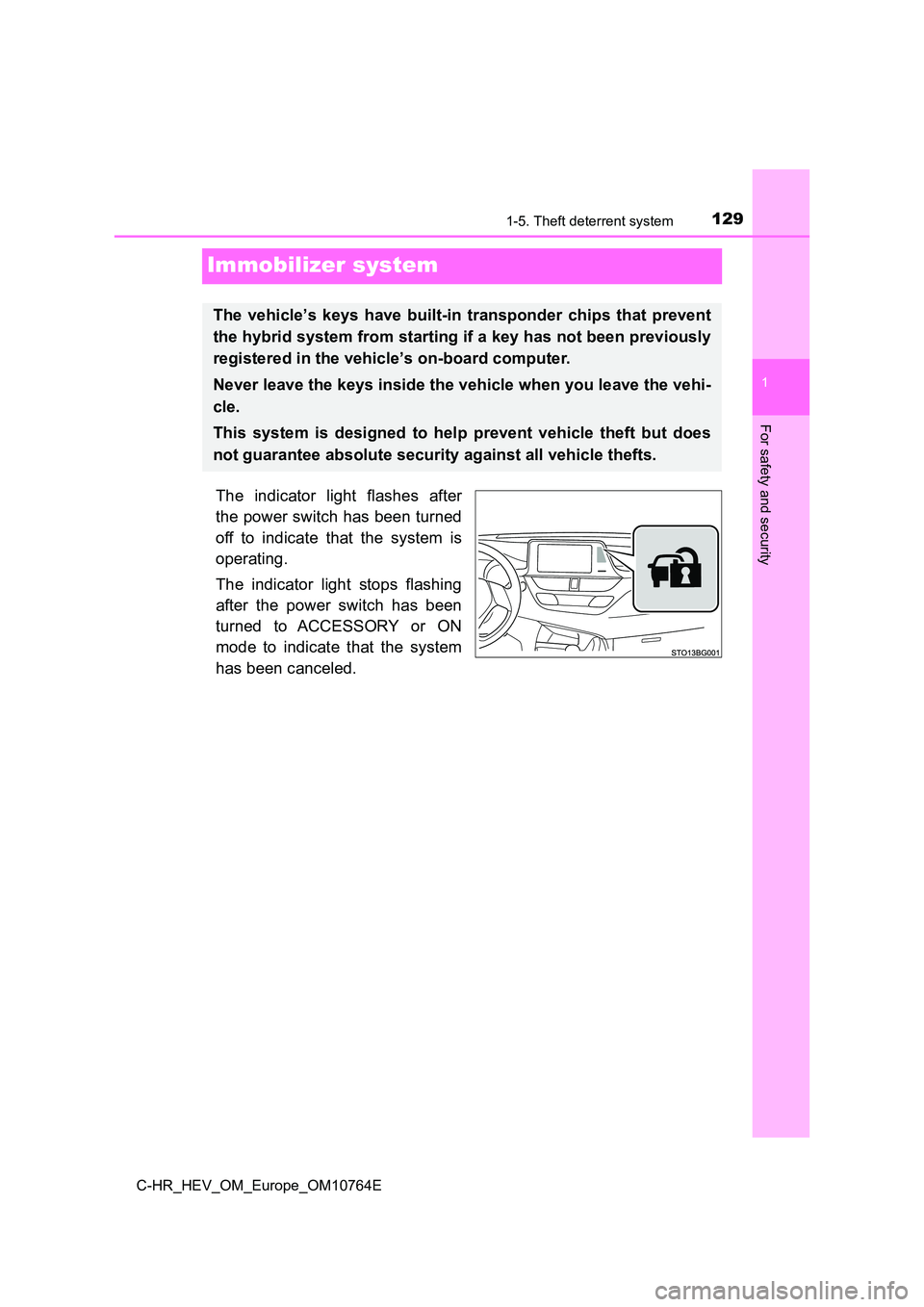
129
1
1-5. Theft deterrent system
For safety and security
C-HR_HEV_OM_Europe_OM10764E
Immobilizer system
The indicator light flashes after
the power switch has been turned
off to indicate that the system is
operating.
The indicator light stops flashing
after the power switch has been
turned to ACCESSORY or ON
mode to indicate that the system
has been canceled.
The vehicle’s keys have built-in transponder chips that prevent
the hybrid system from starting if a key has not been previousl y
registered in the vehicle’s on-board computer.
Never leave the keys inside the vehicle when you leave the vehi -
cle.
This system is designed to help prevent vehicle theft but does
not guarantee absolute security against all vehicle thefts.
Page 152 of 814
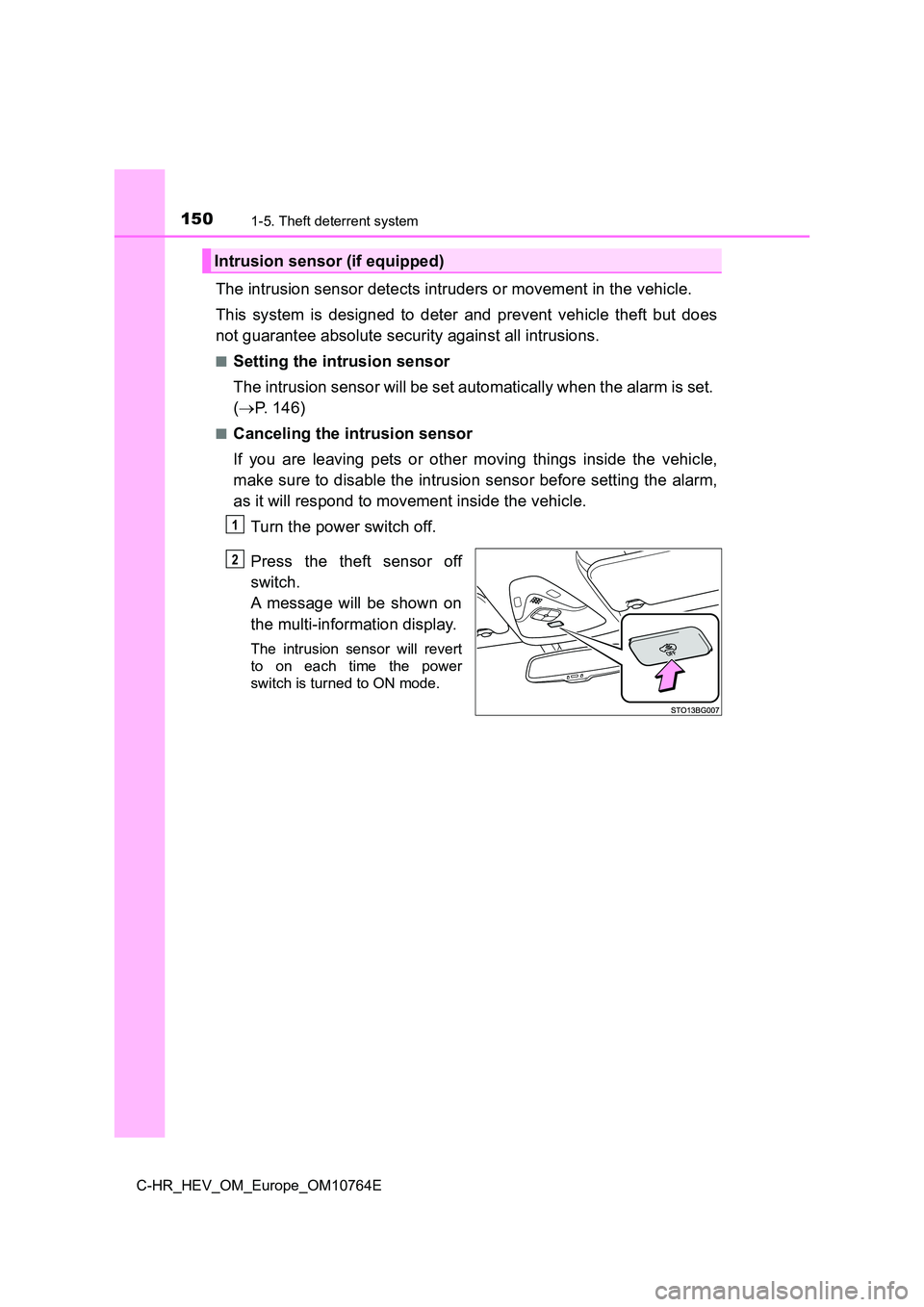
1501-5. Theft deterrent system
C-HR_HEV_OM_Europe_OM10764E
The intrusion sensor detects intruders or movement in the vehicle.
This system is designed to deter and prevent vehicle theft but does
not guarantee absolute security against all intrusions.
■Setting the intrusion sensor
The intrusion sensor will be set automatically when the alarm i s set.
( P. 146)
■Canceling the intrusion sensor
If you are leaving pets or other moving things inside the vehic le,
make sure to disable the intrusion sensor before setting the al arm,
as it will respond to movement inside the vehicle.
Turn the power switch off.
Press the theft sensor off
switch.
A message will be shown on
the multi-information display.
The intrusion sensor will revert
to on each time the power
switch is turned to ON mode.
Intrusion sensor (if equipped)
1
2
Page 159 of 814
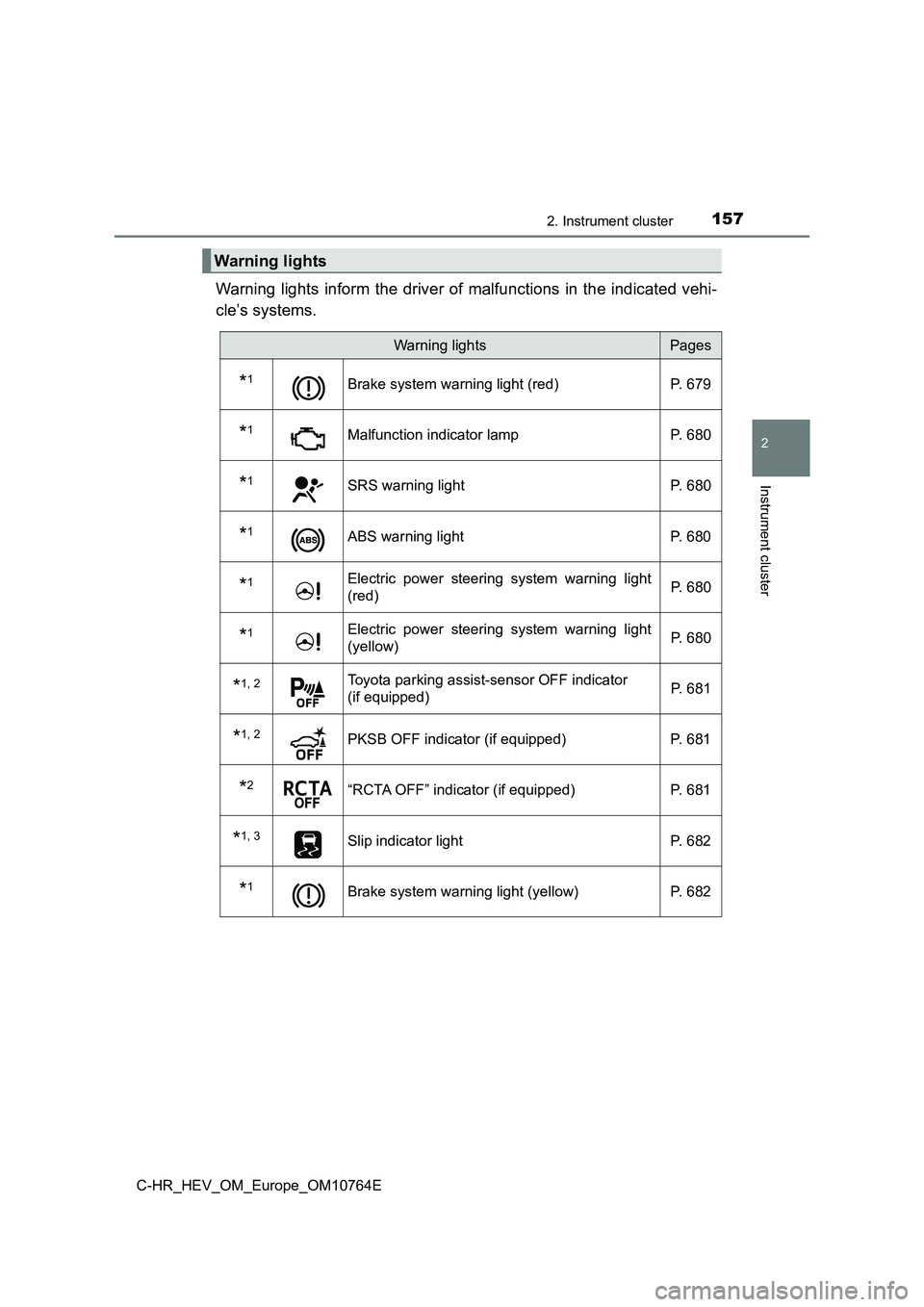
1572. Instrument cluster
2
Instrument cluster
C-HR_HEV_OM_Europe_OM10764E
Warning lights inform the driver of malfunctions in the indicated vehi-
cle’s systems.
Warning lights
Warning lightsPages
*1Brake system warning light (red) P. 679
*1Malfunction indicator lamp P. 680
*1SRS warning light P. 680
*1ABS warning light P. 680
*1Electric power steering system warning light
(red) P. 6 8 0
*1Electric power steering system warning light
(yellow) P. 6 8 0
*1, 2Toyota parking assist-sensor OFF indicator
(if equipped) P. 6 8 1
*1, 2PKSB OFF indicator (if equipped) P. 681
*2“RCTA OFF” indicator (if equipped) P. 681
*1, 3Slip indicator light P. 682
*1Brake system warning light (yellow) P. 682
Page 165 of 814
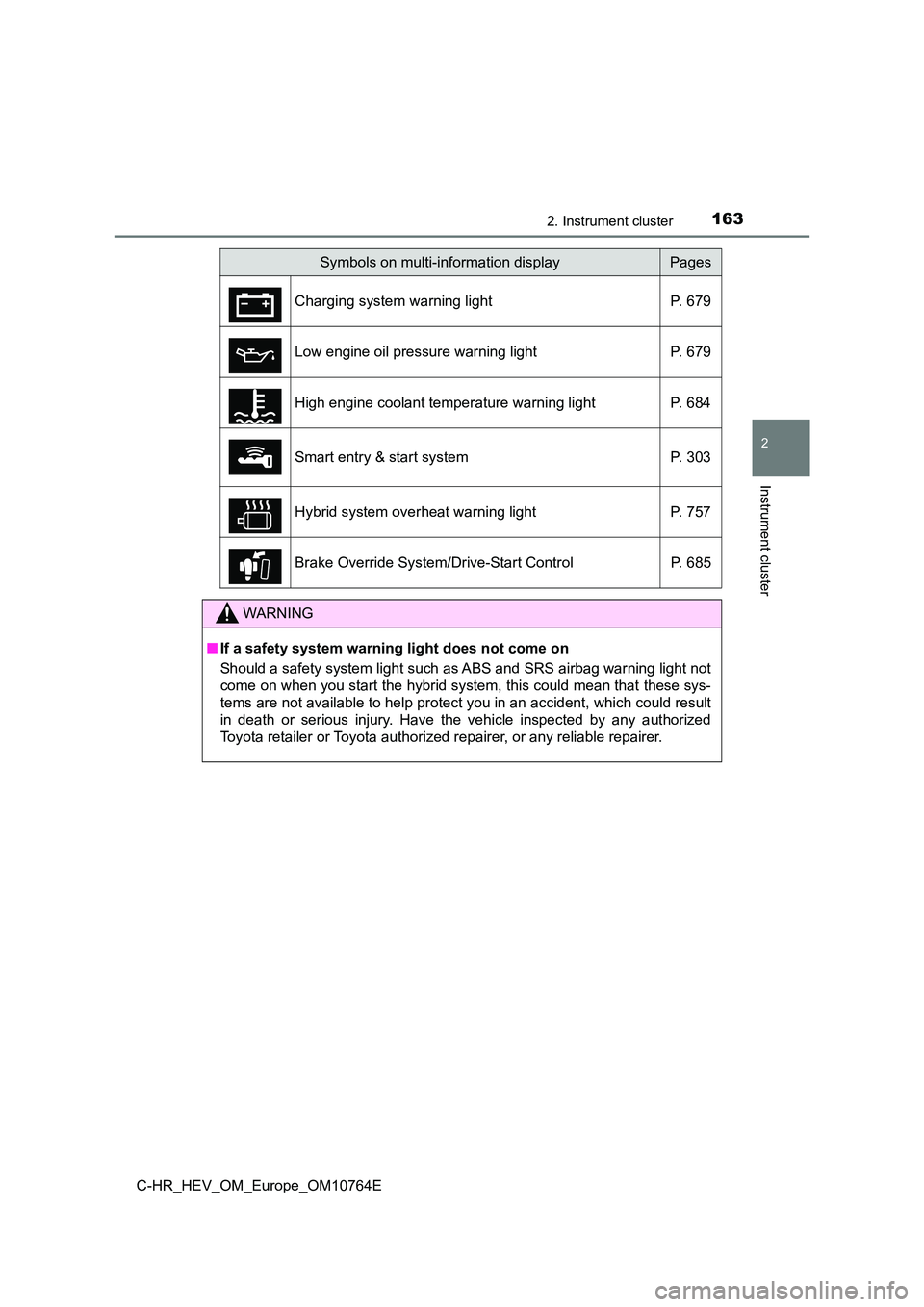
1632. Instrument cluster
2
Instrument cluster
C-HR_HEV_OM_Europe_OM10764E
Symbols on multi-information displayPages
Charging system warning light P. 679
Low engine oil pressure warning light P. 679
High engine coolant temperature warning light P. 684
Smart entry & start system P. 303
Hybrid system overheat warning light P. 757
Brake Override System/Drive-Start Control P. 685
WARNING
■ If a safety system warning light does not come on
Should a safety system light such as ABS and SRS airbag warning light not
come on when you start the hybrid system, this could mean that these sys-
tems are not available to help protect you in an accident, whic h could result
in death or serious injury. Have the vehicle inspected by any a uthorized
Toyota retailer or Toyota authorized repairer, or any reliable repairer.
Page 398 of 814
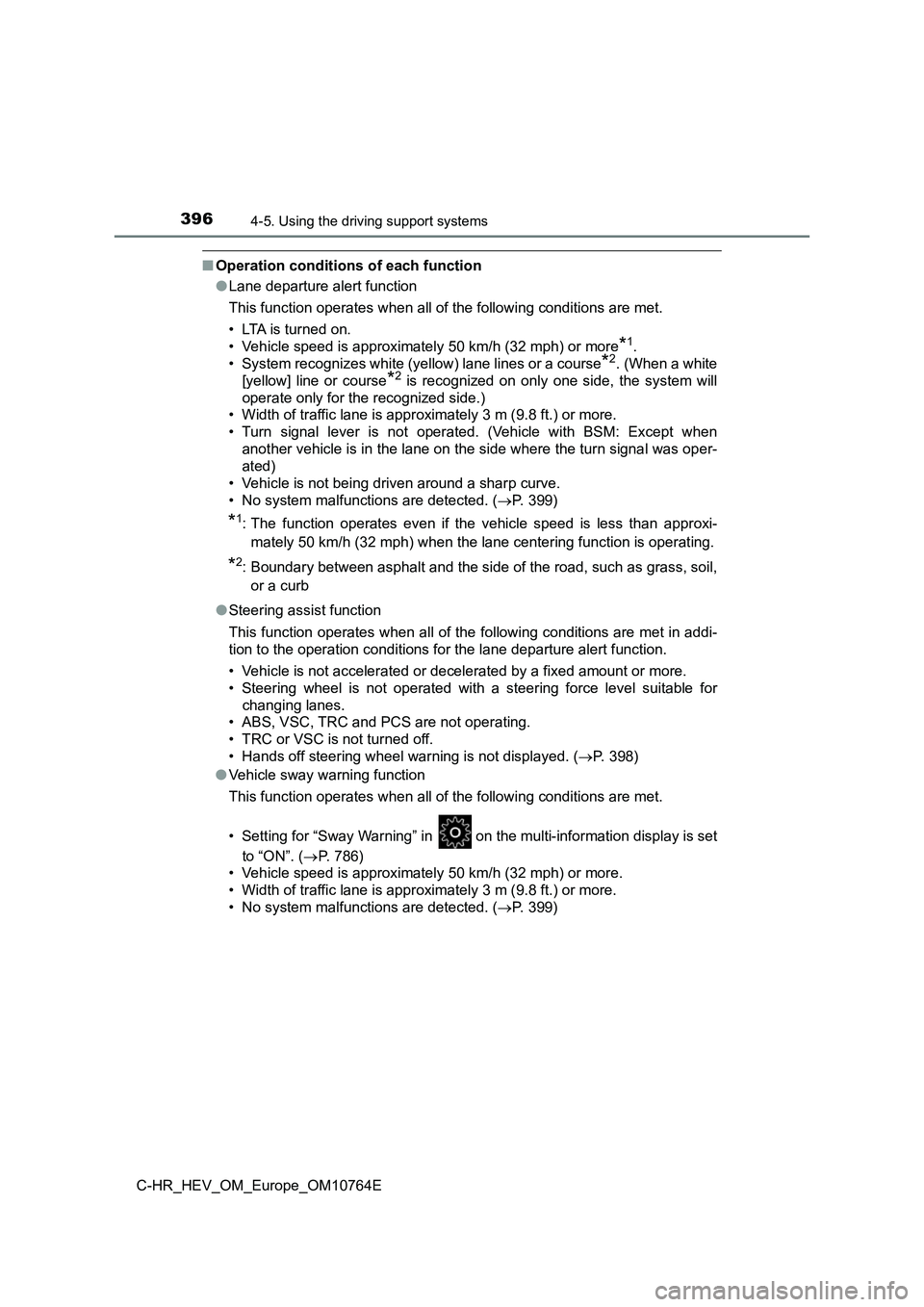
3964-5. Using the driving support systems
C-HR_HEV_OM_Europe_OM10764E
■Operation conditions of each function
● Lane departure alert function
This function operates when all of the following conditions are met.
• LTA is turned on.
• Vehicle speed is approximately 50 km/h (32 mph) or more*1.
• System recognizes white (yellow) lane lines or a course*2. (When a white
[yellow] line or course*2 is recognized on only one side, the system will
operate only for the recognized side.)
• Width of traffic lane is approximately 3 m (9.8 ft.) or more.
• Turn signal lever is not operated. (Vehicle with BSM: Except w hen
another vehicle is in the lane on the side where the turn signa l was oper-
ated)
• Vehicle is not being driven around a sharp curve.
• No system malfunctions are detected. ( P. 399)
*1: The function operates even if the vehicle speed is less than approxi-
mately 50 km/h (32 mph) when the lane centering function is ope rating.
*2: Boundary between asphalt and the side of the road, such as grass, soil,
or a curb
● Steering assist function
This function operates when all of the following conditions are met in addi-
tion to the operation conditions for the lane departure alert f unction.
• Vehicle is not accelerated or decelerated by a fixed amount or more.
• Steering wheel is not operated with a steering force level sui table for
changing lanes.
• ABS, VSC, TRC and PCS are not operating.
• TRC or VSC is not turned off.
• Hands off steering wheel warning is not displayed. ( P. 398)
● Vehicle sway warning function
This function operates when all of the following conditions are met.
• Setting for “Sway Warning” in on the multi-information displa y is set
to “ON”. ( P. 786)
• Vehicle speed is approximately 50 km/h (32 mph) or more.
• Width of traffic lane is approximately 3 m (9.8 ft.) or more.
• No system malfunctions are detected. ( P. 399)
Page 399 of 814
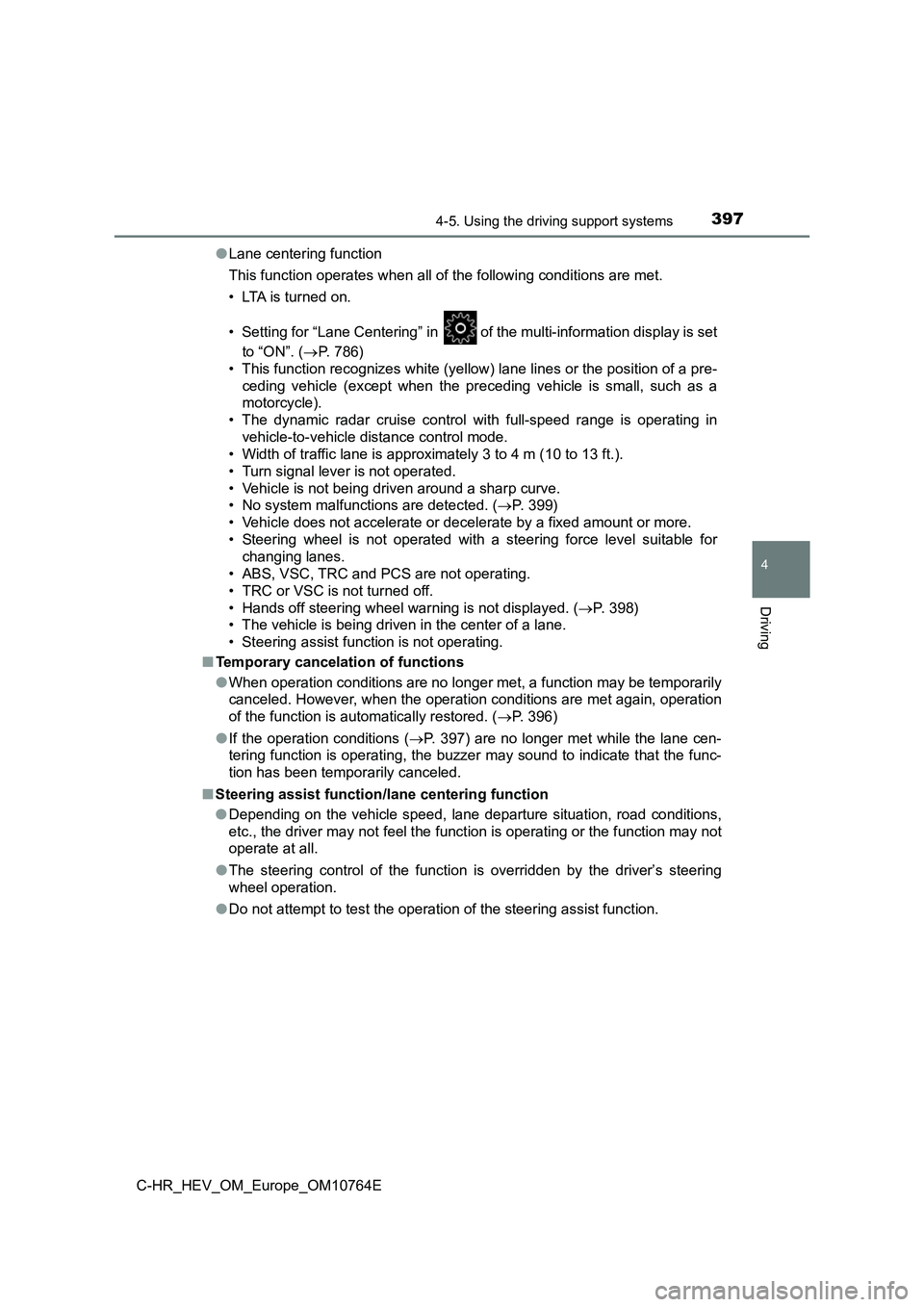
3974-5. Using the driving support systems
4
Driving
C-HR_HEV_OM_Europe_OM10764E
● Lane centering function
This function operates when all of the following conditions are met.
• LTA is turned on.
• Setting for “Lane Centering” in of the multi-information disp lay is set
to “ON”. ( P. 786)
• This function recognizes white (yellow) lane lines or the position of a pre-
ceding vehicle (except when the preceding vehicle is small, suc h as a
motorcycle).
• The dynamic radar cruise control with full-speed range is oper ating in
vehicle-to-vehicle distance control mode.
• Width of traffic lane is approximately 3 to 4 m (10 to 13 ft.) .
• Turn signal lever is not operated.
• Vehicle is not being driven around a sharp curve.
• No system malfunctions are detected. ( P. 399)
• Vehicle does not accelerate or decelerate by a fixed amount or more.
• Steering wheel is not operated with a steering force level sui table for
changing lanes.
• ABS, VSC, TRC and PCS are not operating.
• TRC or VSC is not turned off.
• Hands off steering wheel warning is not displayed. ( P. 398)
• The vehicle is being driven in the center of a lane.
• Steering assist function is not operating.
■ Temporary cancelation of functions
● When operation conditions are no longer met, a function may be temporarily
canceled. However, when the operation conditions are met again, operation
of the function is automatically restored. ( P. 396)
● If the operation conditions (P. 397) are no longer met while the lane cen-
tering function is operating, the buzzer may sound to indicate that the func-
tion has been temporarily canceled.
■ Steering assist function/lane centering function
● Depending on the vehicle speed, lane departure situation, road conditions,
etc., the driver may not feel the function is operating or the function may not
operate at all.
● The steering control of the function is overridden by the driver’s steering
wheel operation.
● Do not attempt to test the operation of the steering assist function.
Page 412 of 814
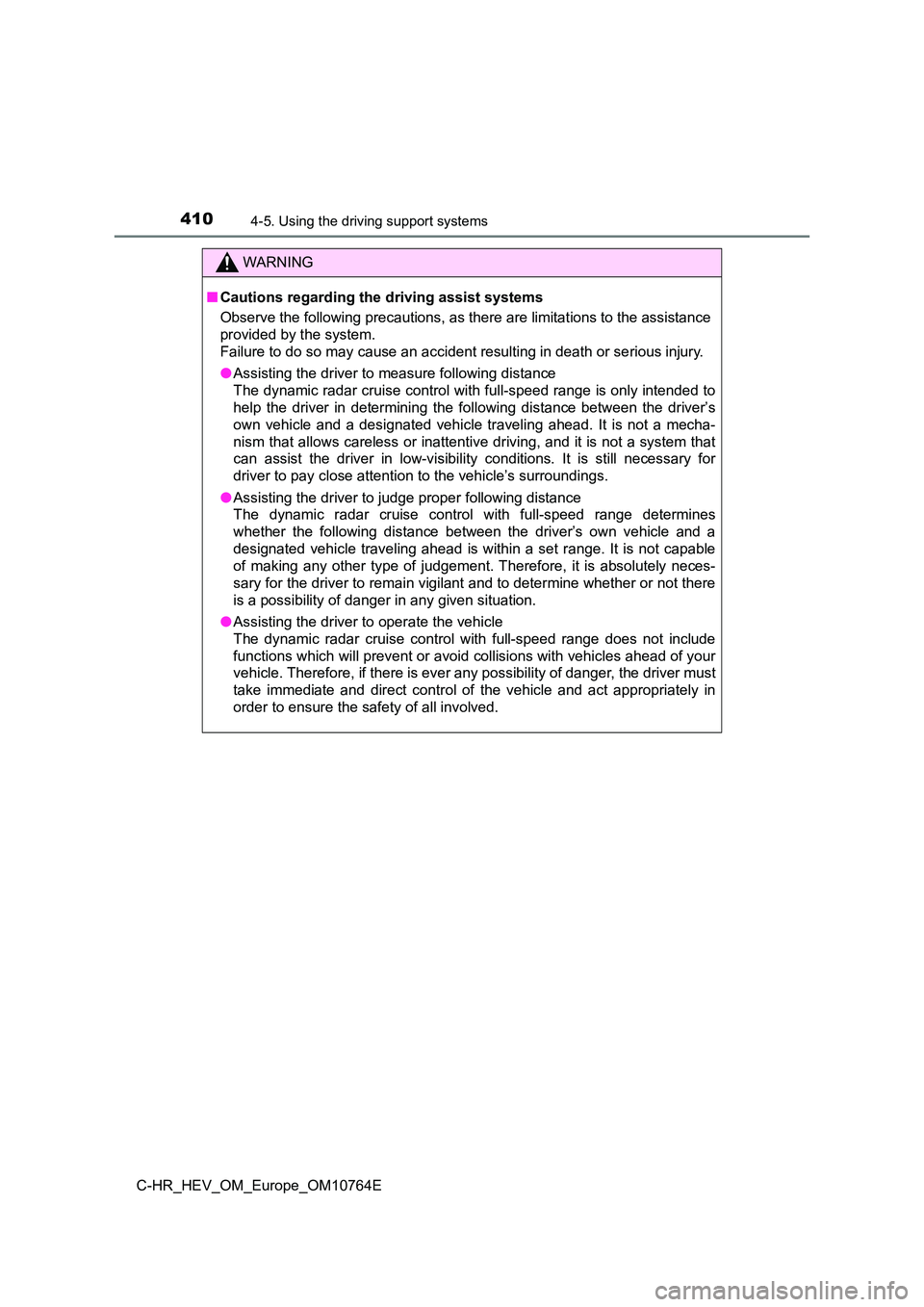
4104-5. Using the driving support systems
C-HR_HEV_OM_Europe_OM10764E
WARNING
■Cautions regarding the driving assist systems
Observe the following precautions, as there are limitations to the assistance
provided by the system.
Failure to do so may cause an accident resulting in death or se rious injury.
● Assisting the driver to measure following distance
The dynamic radar cruise control with full-speed range is only intended to
help the driver in determining the following distance between t he driver’s
own vehicle and a designated vehicle traveling ahead. It is not a mecha-
nism that allows careless or inattentive driving, and it is not a system that
can assist the driver in low-visibility conditions. It is still necessary for
driver to pay close attention to the vehicle’s surroundings.
● Assisting the driver to judge proper following distance
The dynamic radar cruise contro l with full-speed range determines
whether the following distance between the driver’s own vehicle and a
designated vehicle traveling ahead is within a set range. It is not capable
of making any other type of judgement. Therefore, it is absolut ely neces-
sary for the driver to remain vigilant and to determine whether or not there
is a possibility of danger in any given situation.
● Assisting the driver to operate the vehicle
The dynamic radar cruise control with full-speed range does not include
functions which will prevent or avoid collisions with vehicles ahead of your
vehicle. Therefore, if there is ever any possibility of danger, the driver must
take immediate and direct control of the vehicle and act approp riately in
order to ensure the safety of all involved.
Page 463 of 814
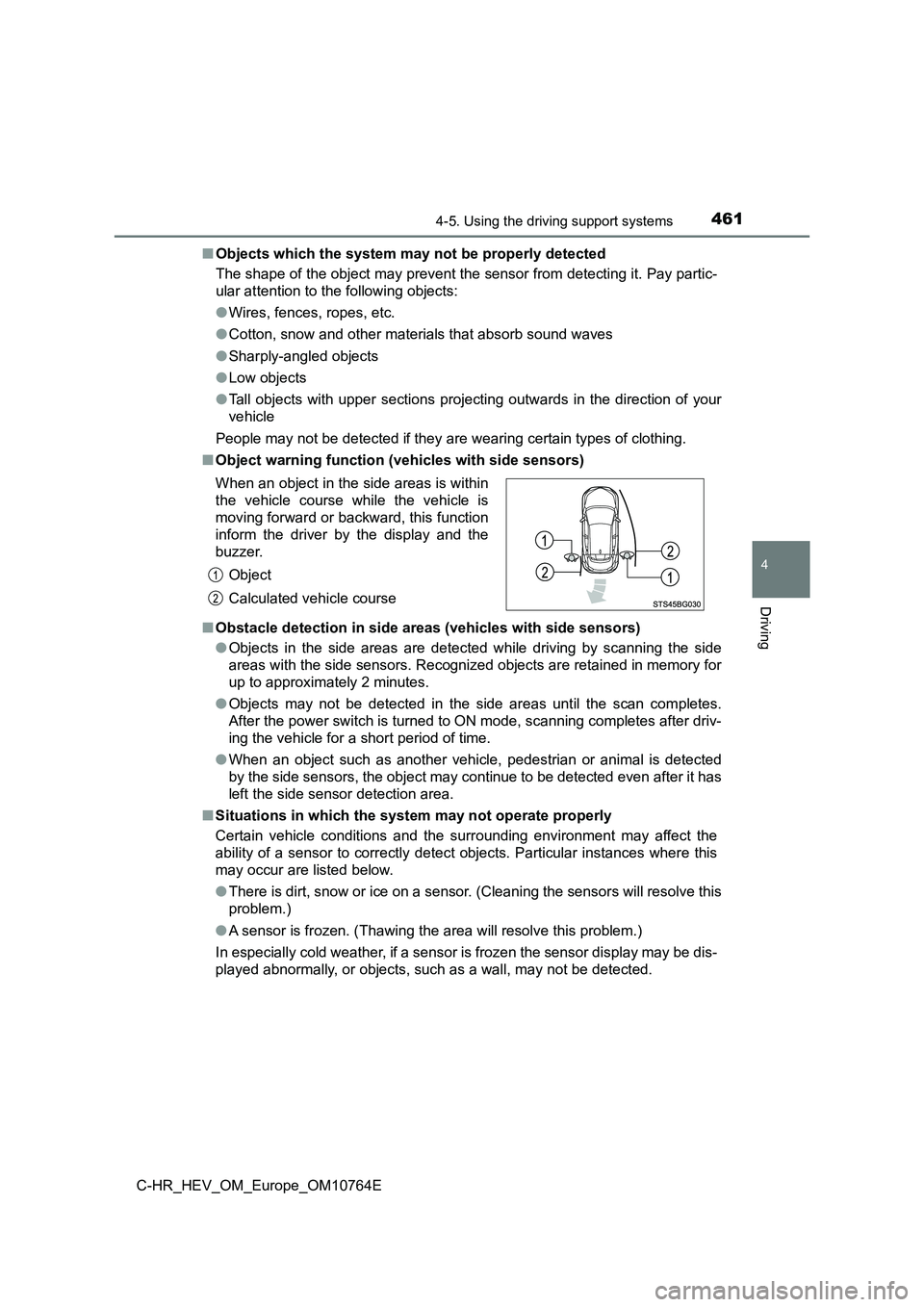
4614-5. Using the driving support systems
4
Driving
C-HR_HEV_OM_Europe_OM10764E
■ Objects which the system may not be properly detected
The shape of the object may prevent the sensor from detecting i t. Pay partic-
ular attention to the following objects:
● Wires, fences, ropes, etc.
● Cotton, snow and other materials that absorb sound waves
● Sharply-angled objects
● Low objects
● Tall objects with upper sections projecting outwards in the direction of your
vehicle
People may not be detected if they are wearing certain types of clothing.
■ Object warning function (vehicles with side sensors)
■ Obstacle detection in side areas (vehicles with side sensors)
● Objects in the side areas are detected while driving by scanning the side
areas with the side sensors. Recognized objects are retained in memory for
up to approximately 2 minutes.
● Objects may not be detected in the side areas until the scan completes.
After the power switch is turned to ON mode, scanning completes after driv-
ing the vehicle for a short period of time.
● When an object such as another vehicle, pedestrian or animal is detected
by the side sensors, the object may continue to be detected eve n after it has
left the side sensor detection area.
■ Situations in which the system may not operate properly
Certain vehicle conditions and the surrounding environment may affect the
ability of a sensor to correctly detect objects. Particular ins tances where this
may occur are listed below.
● There is dirt, snow or ice on a sensor. (Cleaning the sensors will resolve this
problem.)
● A sensor is frozen. (Thawing the area will resolve this problem.)
In especially cold weather, if a sensor is frozen the sensor di splay may be dis-
played abnormally, or objects, such as a wall, may not be detec ted.
When an object in the side areas is within
the vehicle course while the vehicle is
moving forward or backward, this function
inform the driver by the display and the
buzzer.
Object
Calculated vehicle course
Page 532 of 814
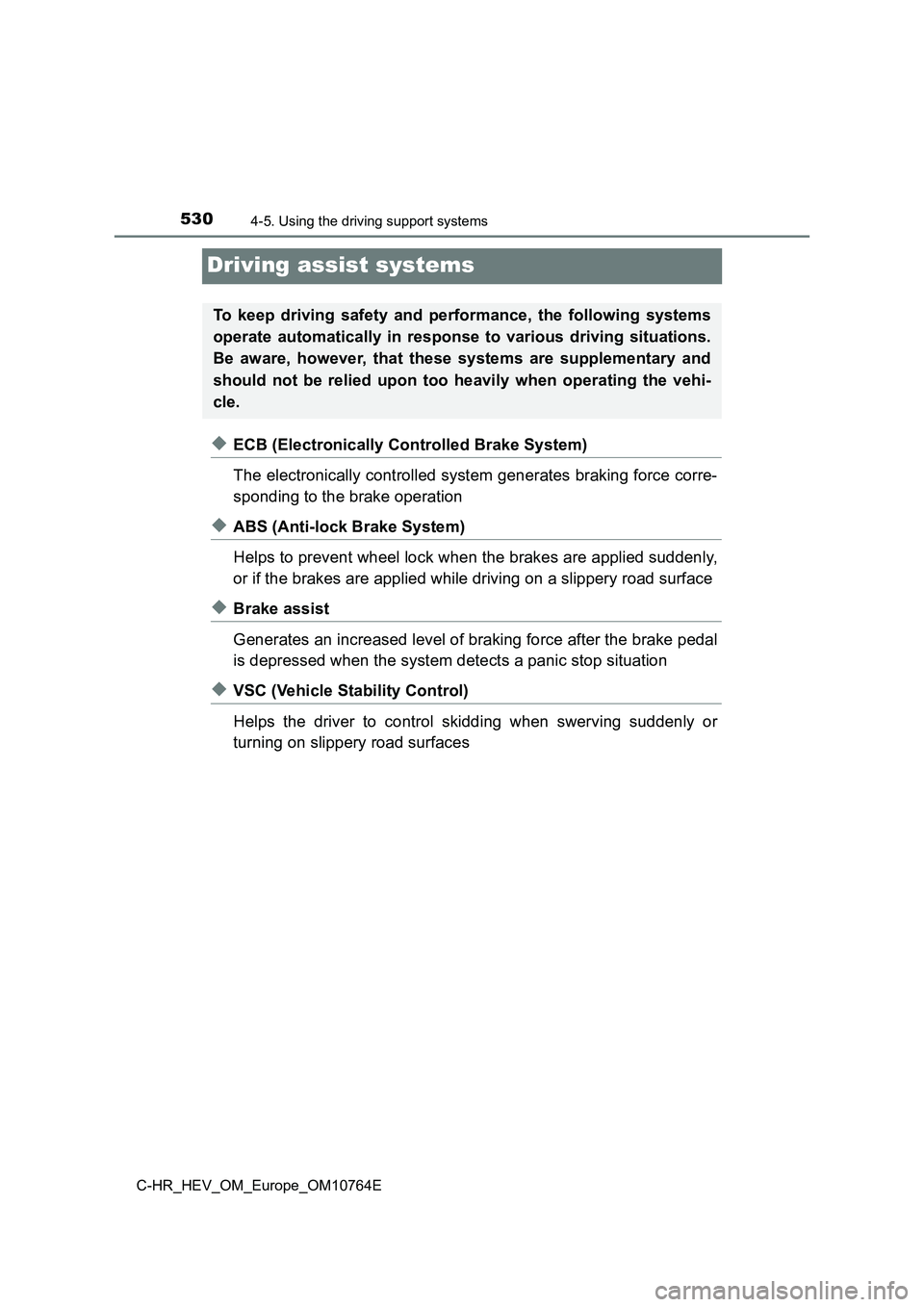
5304-5. Using the driving support systems
C-HR_HEV_OM_Europe_OM10764E
Driving assist systems
◆ECB (Electronically Controlled Brake System)
The electronically controlled system generates braking force co rre-
sponding to the brake operation
◆ABS (Anti-lock Brake System)
Helps to prevent wheel lock when the brakes are applied suddenl y,
or if the brakes are applied while driving on a slippery road s urface
◆Brake assist
Generates an increased level of braking force after the brake p edal
is depressed when the system detects a panic stop situation
◆VSC (Vehicle Stability Control)
Helps the driver to control skidding when swerving suddenly or
turning on slippery road surfaces
To keep driving safety and performance, the following systems
operate automatically in response to various driving situations .
Be aware, however, that these systems are supplementary and
should not be relied upon too heavily when operating the vehi-
cle.
Page 533 of 814
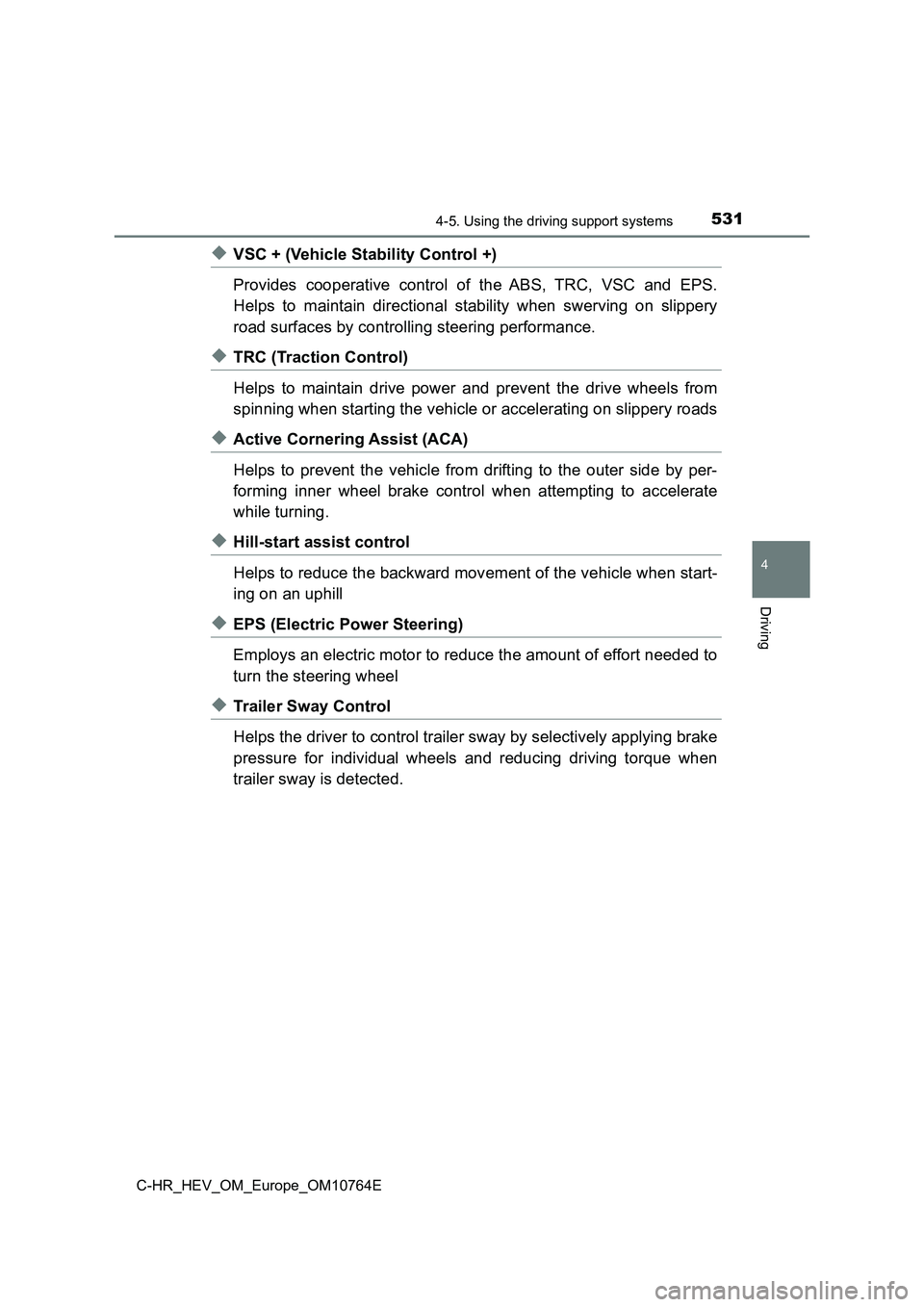
5314-5. Using the driving support systems
4
Driving
C-HR_HEV_OM_Europe_OM10764E
◆VSC + (Vehicle Stability Control +)
Provides cooperative control of the ABS, TRC, VSC and EPS.
Helps to maintain directional stability when swerving on slippe ry
road surfaces by controlling steering performance.
◆TRC (Traction Control)
Helps to maintain drive power and prevent the drive wheels from
spinning when starting the vehicle or accelerating on slippery roads
◆Active Cornering Assist (ACA)
Helps to prevent the vehicle from drifting to the outer side by per-
forming inner wheel brake control when attempting to accelerate
while turning.
◆Hill-start assist control
Helps to reduce the backward movement of the vehicle when start -
ing on an uphill
◆EPS (Electric Power Steering)
Employs an electric motor to reduce the amount of effort needed to
turn the steering wheel
◆Trailer Sway Control
Helps the driver to control trailer sway by selectively applyin g brake
pressure for individual wheels and reducing driving torque when
trailer sway is detected.